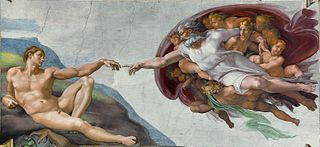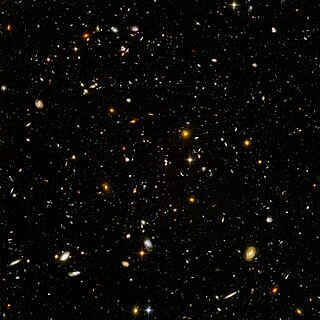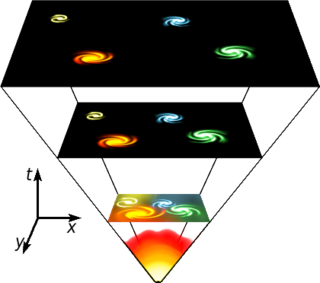
The Big Bang is a physical theory that describes how the universe expanded from an initial state of high density and temperature. It was first proposed in 1927 by Roman Catholic priest and physicist Georges Lemaître. Various cosmological models of the Big Bang explain the evolution of the observable universe from the earliest known periods through its subsequent large-scale form. These models offer a comprehensive explanation for a broad range of observed phenomena, including the abundance of light elements, the cosmic microwave background (CMB) radiation, and large-scale structure. The overall uniformity of the universe, known as the flatness problem, is explained through cosmic inflation: a sudden and very rapid expansion of space during the earliest moments. However, physics currently lacks a widely accepted theory of quantum gravity that can successfully model the earliest conditions of the Big Bang.

Creationism is the religious belief that nature, and aspects such as the universe, Earth, life, and humans, originated with supernatural acts of divine creation. In its broadest sense, creationism includes a continuum of religious views, which vary in their acceptance or rejection of scientific explanations such as evolution that describe the origin and development of natural phenomena.

The world is the totality of entities, the whole of reality, or everything that exists. The nature of the world has been conceptualized differently in different fields. Some conceptions see the world as unique while others talk of a "plurality of worlds". Some treat the world as one simple object while others analyze the world as a complex made up of parts.

Cosmogony is any model concerning the origin of the cosmos or the universe.
A creator deity or creator god is a deity responsible for the creation of the Earth, world, and universe in human religion and mythology. In monotheism, the single God is often also the creator. A number of monolatristic traditions separate a secondary creator from a primary transcendent being, identified as a primary creator.

Georges Henri Joseph Édouard Lemaître was a Belgian Catholic priest, theoretical physicist, mathematician, astronomer, and professor of physics at the Catholic University of Louvain. He was the first to theorize that the recession of nearby galaxies can be explained by an expanding universe, which was observationally confirmed soon afterwards by Edwin Hubble. He first derived "Hubble's law", now called the Hubble–Lemaître law by the IAU, and published the first estimation of the Hubble constant in 1927, two years before Hubble's article. Lemaître also proposed the "Big Bang theory" of the origin of the universe, calling it the "hypothesis of the primeval atom", and later calling it "the beginning of the world".

Old Earth creationism (OEC) is an umbrella of theological views encompassing certain varieties of creationism which may or can include day-age creationism, gap creationism, progressive creationism, and sometimes theistic evolutionism.

Religious cosmology is an explanation of the origin, evolution, and eventual fate of the universe from a religious perspective. This may include beliefs on origin in the form of a creation myth, subsequent evolution, current organizational form and nature, and eventual fate or destiny. There are various traditions in religion or religious mythology asserting how and why everything is the way it is and the significance of it all. Religious cosmologies describe the spatial lay-out of the universe in terms of the world in which people typically dwell as well as other dimensions, such as the seven dimensions of religion; these are ritual, experiential and emotional, narrative and mythical, doctrinal, ethical, social, and material.

The Kalam cosmological argument is a modern formulation of the cosmological argument for the existence of God. It is named after the Kalam, from which its key ideas originated. William Lane Craig was principally responsible for giving new life to the argument in the 20th century, due to his book The Kalām Cosmological Argument (1979), among other writings.

Creatio ex nihilo is the doctrine that matter is not eternal but had to be created by some divine creative act. It is a theistic answer to the question of how the universe came to exist. It is in contrast to Ex nihilo nihil fit or "nothing comes from nothing", which means that all things were formed ex materia from preexisting things; an idea by the Greek philosopher Parmenides about the nature of all things, and later more formally stated by Titus Lucretius Carus.

Islamic views on evolution are diverse, ranging from theistic evolution to Old Earth creationism. Some Muslims around the world believe "humans and other living things have evolved over time", yet some others believe they have "always existed in present form". Some Muslims believe that the processes of life on Earth started from one single point of species with a mixture of water and a viscous clay-like substance. Muslim thinkers have proposed and accepted elements of the theory of evolution, some holding the belief of the supremacy of God in the process. Some scholars suggested that both narratives of creation and of evolution, as understood by modern science, may be believed by modern Muslims as addressing two different kinds of truth, the revealed and the empirical. Others argue that faith and science can be integrated and complement each other.
In philosophy, theophysics is an approach to cosmology that attempts to reconcile physical cosmology and religious cosmology. It is related to physicotheology, the difference between them being that the aim of physicotheology is to derive theology from physics, whereas that of theophysics is to unify physics and theology.

The history of the Big Bang theory began with the Big Bang's development from observations and theoretical considerations. Much of the theoretical work in cosmology now involves extensions and refinements to the basic Big Bang model. The theory itself was originally formalised by Father Georges Lemaître in 1927. Hubble's Law of the expansion of the universe provided foundational support for the theory.

Unity of religion is a core teaching of the Baháʼí Faith which states that there is a fundamental unity in many of the world's religions. The principle states that the teachings of the major religions are part of a single plan directed from the same God. It is one of the core teachings of the Baháʼí Faith, alongside the unity of God, and the unity of humanity.

In monotheistic belief systems, God is usually viewed as the supreme being, creator, and principal object of faith. In polytheistic belief systems, a god is "a spirit or being believed to have created, or for controlling some part of the universe or life, for which such a deity is often worshipped". Belief in the existence of at least one god is called theism.
Muslim scholars have developed a spectrum of viewpoints on science within the context of Islam. The Quran and Islam allows much interpretation when it comes to science. Scientists of medieval Muslim civilization contributed to the new discoveries in science. From the eighth to fifteenth century, Muslim mathematicians and astronomers furthered the development of almost all areas of mathematics. At the same time, concerns have been raised about the lack of scientific literacy in parts of the modern Muslim world.

In Baháʼí cosmology reality is divided into three divisions. The first division is God, who is preexistent and on whom the rest of creation is contingent. The second division is God's Logos, the Primal Will, which is the realm of God's commands and grace. This realm pervades all created things. The Manifestations of God, Messengers from God, are appearances of the Logos in the physical world. The third division is Creation, which includes the physical world. Creation is not seen as confined to the material universe, and individual material objects, such as the Earth, are seen to come into being at particular moment and subsequently break down into their constituent parts. Thus, the current universe is seen as a result of a long-lasting process, evolving to its current state. In the Baháʼí Faith, the whole universe is a sign of God and is dependent on him and humanity was created to know God and to serve his purpose.
The following outline is provided as an overview of and topical guide to metaphysics:
Although biological evolution has been vocally opposed by some religious groups, many other groups accept the scientific position, sometimes with additions to allow for theological considerations. The positions of such groups are described by terms including "theistic evolution", "theistic evolutionism" or "evolutionary creation". Of all the religious groups included on the chart, Buddhists are the most accepting of evolution. Theistic evolutionists believe that there is a God, that God is the creator of the material universe and all life within, and that biological evolution is a natural process within that creation. Evolution, according to this view, is simply a tool that God employed to develop human life. According to the American Scientific Affiliation, a Christian organization of scientists:
A theory of theistic evolution (TE) — also called evolutionary creation — proposes that God's method of creation was to cleverly design a universe in which everything would naturally evolve. Usually the "evolution" in "theistic evolution" means Total Evolution — astronomical evolution and geological evolution plus chemical evolution and biological evolution — but it can refer only to biological evolution.

The Hadith of the Hidden Treasure is a hadith qudsi that has a very prominent role in Islamic mysticism and Islamic philosophy.












